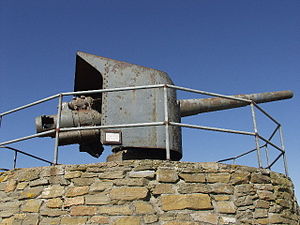15 cm SK L/45
| 15 cm SK L/45 | |
|---|---|
 | |
| Type | Naval gun Railroad gun Coastal artillery |
| Place of origin | German Empire |
| Service history | |
| In service | 1908—45 |
| Used by | Germany |
| Wars | World War I World War II |
| Production history | |
| Designer | Krupp |
| Designed | 1906 |
| Manufacturer | Krupp |
| Produced | 1908 |
| Specifications | |
| Mass | 5,730 kilograms (12,630 lb) |
| Length | 6.71 metres (22 ft 0 in) |
| Barrel length | 6.32 metres (20 ft 9 in)L/45 |
| Shell | separate loading quick fire |
| Caliber | 149.1 millimetres (5.87 in) |
| Breech | horizontal sliding-wedge |
| Recoil | Hydro-spring |
| Elevation | See table |
| Traverse | −150° to +150° |
| Rate of fire | 5-7 rpm |
| Muzzle velocity | 840 metres per second (2,800 ft/s) |
| Maximum firing range | See table |
The 15 cm SK L/45[Note 1] was a German naval gun used in World War I and World War II.
[edit]
The 15 cm SK L/45 was a widely used naval gun on many classes of World War I dreadnoughts and cruisers in both casemates and turrets. It was constructed of an A tube and two layers of hoops with a Krupp horizontal sliding-wedge breech block. During World War I a few pre-war cruisers that were armed with 10.5 cm guns were rearmed with these weapons. In World War II the 15 cm SK L/45 was widely used as coastal artillery and as primary armament on German auxiliary cruisers.
Ship classes that carried the 15 cm SK L/45 include:
| Type of mount | Designation | Weight | Elevation | Range (during World War I) | Ship classes |
| Single pedestal mounts in casemates | MPL C/06 | 15,770 kg (34,770 lb) | −7° to +20° | 14.9 km (9.3 mi) at 20° | Nassau, Helgoland, Kaiser, von der Tann, Moltke, Blücher |
| MPL C/06.11 | 16,533 kg (36,449 lb) | −10° to +19° | 13.5 km (8.4 mi) at +19 | König, Seydlitz, Derfflinger, Lutzow | |
| MPL C/13 | 17,950 kg (39,570 lb) | −8.5° to +19 | 13.5 km (8.4 mi) at +19 | Bayern, Hindenburg, Mackensen | |
| MPL C/13 mod | 18,350 kg (40,450 lb) | −8.5° to +22 | 15.8 km (9.8 mi) at +22 | Wartime modification to MPL C/13 | |
| Single pedestal mounts in open half-shields | MPL C/14 | 16,185 kg (35,682 lb) | −10° to +22° | 15.8 km (9.8 mi) at +22 | Wiesbaden, Königsberg II |
| MPL C/16 | 17,116 kg (37,734 lb) | −10° to +27° | 16.8 km (10.4 mi) at +27 | Cöln II, Emden II | |
| MPL C/16 mod | −10° to +30 | 17.6 km (10.9 mi) at +30 | wartime modification to MPL C/16 |
Ammunition[edit]
Ammunition was of separate loading quick fire type. The projectiles were 61 cm (2 ft) long with a single bagged charge which weighed 13–14 kg (29–31 lb).
The gun was able to fire:
- Armor piercing 45.3 kg (100 lb)
- High explosive base fuzed 45.3 kg (100 lb)
- High explosive nose fuzed 45.3 kg (100 lb)
- Common shell 45.3 kg (100 lb)
Coast defense gun[edit]


The same gun was used for coast defense duties in concrete emplacements after World War I. One example was 3./Marine-Artillerie Abteilung 604 ("3rd Battery of Naval Artillery Battalion 604") in Jersey.[2] They show it using 44 kilograms (97 lb) shells with a range of 18,000 metres (20,000 yd)
Railroad gun[edit]
It was also used as a railroad gun during World War I.
See also[edit]
Weapons of comparable role, performance and era[edit]
- BL 6 inch Mk XII naval gun British equivalent
Footnotes[edit]
- Notes
- ^ SK - Schnelladekanone (quick loading cannon); L - Länge in Kaliber (length in caliber)
- Citations
References[edit]
- Gander, Terry; Chamberlain, Peter (1979). Weapons of the Third Reich: An Encyclopedic Survey of All Small Arms, Artillery and Special Weapons of the German Land Forces 1939–1945. New York: Doubleday. ISBN 0-385-15090-3.
- Campbell, John (1985). Naval Weapons of World War Two. Naval Institute Press. ISBN 0-87021-459-4.
- Friedman, Norman (2011). Naval Weapons of World War One. Barnsley, South Yorkshire, UK: Seaforth. ISBN 978-1-84832-100-7.
- Gardiner, Robert; Gray, Randal, eds. (1985). Conway's All the World's Fighting Ships 1906–1921. Annapolis, Maryland: Naval Institute Press. ISBN 0-85177-245-5.
